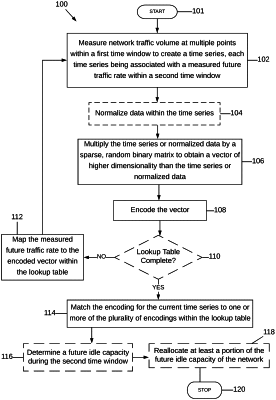| CPC H04L 41/147 (2013.01) [G06F 17/18 (2013.01); H04L 41/142 (2013.01); H04L 41/16 (2013.01); H04L 43/067 (2013.01); H04L 43/0847 (2013.01); H04L 43/0882 (2013.01); H04L 43/106 (2013.01)] | 26 Claims |

|
1. A method for predicting future idle capacity of a network comprising:
measuring traffic volumes on a network during multiple different time windows to obtain a plurality of first data sets, each of the first data sets having associated with it a future traffic rate;
mathematically generating a plurality of vectors, each of the vectors corresponding to and having a higher dimensionality than one of the first data sets;
encoding each of the vectors, thereby generating a plurality of encodings corresponding to the plurality of first data sets;
determining a future traffic value based on the future traffic rate of each of the first data sets that generated a specific encoding selected from the plurality of encodings;
associating the future traffic value with the specific encoding and storing in memory;
repeating the steps of determining and associating for each encoding of the plurality of encodings, thereby generating a plurality of encoding-to-future traffic value associations; measuring current traffic volumes on the network to produce a current traffic volume data set;
creating a current traffic encoding representing the current traffic volumes within the current traffic volume data set;
matching the current traffic encoding to one or more of the encoding-to-future traffic value associations to obtain the future traffic value, which is a predicted future traffic rate for the current traffic volume data set;
subtracting the predicted future traffic rate from a maximum network capacity to determine a future idle capacity; and
reallocating at least a portion of the future idle capacity of the network.
|